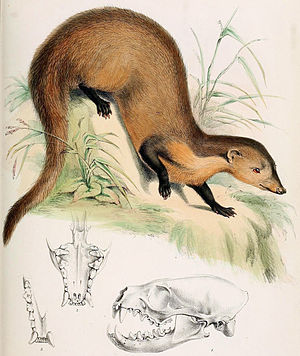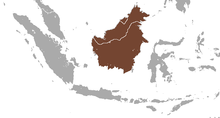Collared mongoose
| Collared mongoose | ||||||||||||
|---|---|---|---|---|---|---|---|---|---|---|---|---|

Collared mongoose ( Herpestes semitorquatus ) |
||||||||||||
| Systematics | ||||||||||||
|
||||||||||||
| Scientific name | ||||||||||||
| Herpestes semitorquatus | ||||||||||||
| ( Gray , 1846) |
The collar mongoose ( Herpestes semitorquatus ) is a species of predator from the mongoose family (Herpestidae). It only occurs on the island of Borneo , possibly also on Sumatra .
Features and systematics
The collar mongoose reaches a head-trunk length of about 40–45.5 cm, the tail measures 28.5–30 cm, which means that it measures more than 60% of the head-trunk length. The weight is around 3–4 kg. The basic color is reddish brown with a yellowish mark on the back. The legs are black-brown in the lower part, the tail is yellowish, as is the underside of the head and neck. From the ears to the shoulders there is a whitish stripe. The top hair is quite short with a length of 10 to 20 mm.
| 3 | · | 1 | · | 4th | · | 2 | = 40 |
The dentition consists of 40 teeth. Occasionally the collar mongoose was considered a subspecies of the short-tailed mongoose , but there is now a consensus that it is a separate species.
distribution and habitat
The species is now only found on Borneo , where it apparently inhabits large parts of the island in the states of Malaysia and Indonesia , probably also Brunei . Only two old museum specimens from 1917 were known from the island of Sumatra for a long time until there was a new record from Aceh in 2012 . The shape of this island has been described as a separate subspecies ( H. s. Uniformis ) in contrast to the form of Borneo ( H. s. Semitorquatus ). However, this classification is unsecured. The collar mongoose can be found in primary and secondary forests as well as in plantations. On Borneo the species occurs from sea level up to 1200 m altitude. Almost nothing is known about the current situation. The IUCN does not indicate a hazard status due to insufficient data (" Data Deficient "). The species was recently identified for the first time in the area of Mount Kinabalu National Park .
Way of life
Little is known about the way of life. Apparently they are solitary animals living on the ground. Evaluations of image material from camera traps suggest that the collar mongoose is diurnal.
Individual evidence
- ↑ a b c J. S. Gilchist, AP Jennings, G. Veron, & P. Cavallini (2009). Family Herpestidaae (Mongooses). In: Don E. Wilson, Russell A. Mittermeier (eds.): Handbook of the Mammals of the World. Volume 1: Carnivores. Lynx Edicions, 2009, ISBN 978-84-96553-49-1 , (pp. 311 f.).
- ↑ To orange-colored Collared Mongoose Herpestes semitorquatus from Aceh, Sumatra, Indonesia ( Memento of the original from December 24, 2013 in the Internet Archive ) Info: The archive link was inserted automatically and has not yet been checked. Please check the original and archive link according to the instructions and then remove this notice. (PDF; 382 kB)
- ↑ Herpestes semitorquatus in the IUCN Red List of Threatened Species 2011.1. Listed by: Hon, J., Duckworth, JW, Azlan, A., Jennings, A. & Veron ,, 2008. Retrieved February 11, 2012.
